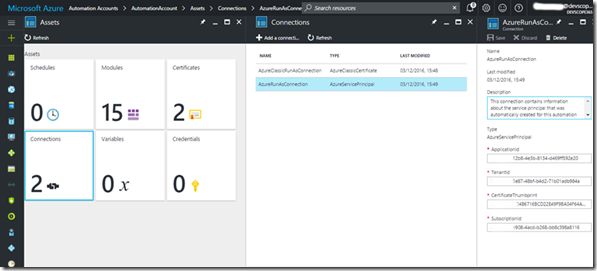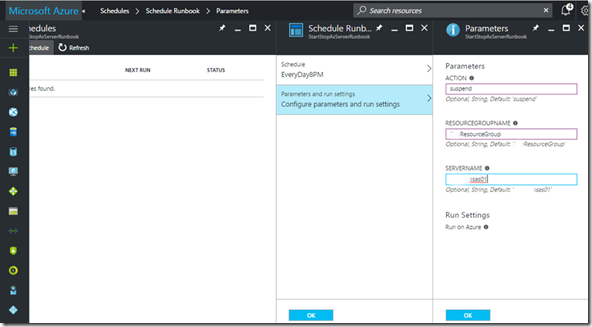This is a guest post from my colleague Filipe Sousa from DevScope who will share is very recent findings in automating management tasks in Azure Analysis Services, take it away Filipe:
Recently we came across the need to use one of the newest Azure services – Azure Analysis Services (AS). This lead us to an awesome Software as a Service (SaaS), dazzling query speed, stunning scalability…and a new administration paradigm, administer SaaS in the cloud.
Since Azure Analysis Services is charged hourly and we know that we will not use the service 24/7, how could we automate the pause/resume feature of the Azure Analysis Service so that we could optimize savings?
Couldn’t be more straightforward, except for some lack of documentation/examples, thanks Josh Caplan for pointing us in the right direction: Azure Analysis Services REST API
First, and so that the REST calls to the ARM API can be authenticated, we need to create an app account in the Azure AD. This can be done manually, as a standalone act or, better yet, as part of an Azure Automation Account with a Run as Account creation. The last will deploy a new service principal in Azure Active Directory (AD) for us, a certificate, as well as assigns the contributor role-based access control so that ARM can use it in further runbooks.
Recap, we will need:
An Azure Automation Account so that we can have:
· Runbook(s) – for the exercise, specifically a powershell runbook;
· A run as account so that the script can authenticate against Azure AD;
· Schedules to run the runbook.
This is how you can achieve it:
(If you already have automation account and don’t have a run as account, create an Application Account in Azure AD.)
Having created the azure automation account, we can peek at the new run as account with the service principal already created for us:
Additionally, we can take the opportunity to gather the application, tenant and subscription id’s, it will serve us latter.
Having the Automation Account in Place is time to create a key for it, go to your app account in Azure AD, in the all settings menu select keys and create a new key with the desired duration. Copy the key value and save it somewhere safe, you won’t be able to get it later!
For now, all we have to do is to collect:
· ApplicationID: in Azure AD –> App Registratons –> The name of app we just created
· Application Key: Collected from the previous steps
· TennantID: Azure Active Directory –> Properties –> Directory ID value
· SubscriptionID: From the Azure URL: https://portal.azure.com/#resource/subscriptions/e583134e-xxxx-xxxx-xxxx-bb8c398a8116/…
· Resource group name: From the Azure URL: https://portal.azure.com/…/resourceGroups/xxxResourceGroup/…
· SSAS server name: Analysis Services -> YourServerName
Having those, replace this values in the below script and save it somewhere for now – we encourage you to develop and test your powershell scripts in powershell IDE –, and yes, this script will also work in an on-premises machine.
#region parameters
param(
[Parameter(Mandatory = $true)]
[ValidateSet('suspend','resume')]
[System.String]$action = 'suspend',
[Parameter(Mandatory = $true)]
[System.String]$resourceGroupName = 'YouResourceGroup',
[Parameter(Mandatory = $true)]
[System.String]$serverName = 'YourAsServerName'
)
#endregion
#region variables
$ClientID = 'YourApplicationId'
$ClientSecret = 'YourApplicationKey'
$tennantid = 'YourTennantId'
$SubscriptionId = 'YourSubsciptionId'
#endregion
#region Get Access Token
$TokenEndpoint = {https://login.windows.net/{0}/oauth2/token} -f $tennantid
$ARMResource = "https://management.core.windows.net/"
$Body = @{
'resource'= $ARMResource
'client_id' = $ClientID
'grant_type' = 'client_credentials'
'client_secret' = $ClientSecret
}
$params = @{
ContentType = 'application/x-www-form-urlencoded'
Headers = @{'accept'='application/json'}
Body = $Body
Method = 'Post'
URI = $TokenEndpoint
}
$token = Invoke-RestMethod @params
#endregion
#region Suspend/Resume AS -> depending on the action parameter
#URI TO RESUME
#POST /subscriptions/{subscriptionId}/resourceGroups/{resourceGroupName}/providers/Microsoft.AnalysisServices/servers/{serverName}/resume?api-version=2016-05-16
#URI TO SUSPEND
#POST /subscriptions/{subscriptionId}/resourceGroups/{resourceGroupName}/providers/Microsoft.AnalysisServices/servers/{serverName}/suspend?api-version=2016-05-16
$requestUri = "https://management.azure.com/subscriptions/$SubscriptionId/resourceGroups/$resourceGroupName/providers/Microsoft.AnalysisServices/servers/$serverName/$action ?api-version=2016-05-16"
$params = @{
ContentType = 'application/x-www-form-urlencoded'
Headers = @{
'authorization'="Bearer $($Token.access_token)"
}
Method = 'Post'
URI = $requestUri
}
Invoke-RestMethod @params
#endregion
With the powershell script assembled – note that one of script parameters is the action (suspend/resume), that we want the script to execute against the SSAS – the next steps are:
· Create a runbook within the early created automation account with the type powershell, paste the previous script, save it and…voilà, ready to test, publish and automate!
· Next step is to publish the runbook so that it can be used in a schedule, fully automating the suspend/resume procedure. After publishing the runbook, create/assign it schedules – one to suspend and other to resume the AS server:
Afterwards configure the desired script parameters for each schedule:
The final result should look like this and give us the desired suspend/resume Azure AS automation.
Hope that you’ve learned from our post, have a nice Azure automation, leave your comments below!
Filipe Sousa








This is really useful, thanks!
Thanks a million for this!
Do you have another script/ tutorial to full process the tabular model in Azure AS?
Thanks Again
Check this out: https://devscopebi.wordpress.com/2017/01/24/managing-analysis-services-tabular-table-partitions-with-powershell/
Thanks, not yet but comming soon 🙂
VMware Certified Advanced Professional 6 (Desktop and Mobility Deployment) – The industry-recognized VCAP6-DTM Deploy certification validates that you know how to deploy and optimize VMware Horizon 6 (with View) environments. It proves that you have the knowledge and expertise required to leverage best practices to provide a scalable and dependable Business Mobility platform for your company. Some of the subject areas involve: Configuring and managing Horizon View components, configuring cloud pod archituecture, configuring Group Policy settings related to Horizon View, Configuring and optimizing desktop images for Horizon View & Mirage, Configuring and managing App Volumes AppStacks, Configuring desktop pools, Configuring and deploying ThinApp packaged applications, Configuring VMWare Identity Manager, etc.Szumigalski.com was designed by Sebastian to propagate his love for PowerShell & VMWare. Sebastian is an IT expert employed in Singapore for more than 15 years who is frequently on the lookout for innovative technological innovation to hone his technical expertise & understanding. Since then, Sebastian has became a member of PowerShell User Group & VMWare VMug group, and has been being involved in all of the gatherings held in Singapore. This website will highlight exactly how Sebastian manage to automate some of his every day duties making use of PowerShell. You can get study guides obtainable for the VCAP6-DTM examination, which were professionally created by Sebastian. Sebastian is certified with VCAP6-DTM, and is professional with virtualization & server maintenance from four years experience of automation. The need for VMWare knowledgable admins and technicians are ever-increasing in the modern technology market place. Become familiar much more about PowerShell & VMWare with Szumigalski.com!
Thanks for this article. In my own testing I initially tried to use the Powershell commands:
Get-AzureRmAnalysisServicesServer
Suspend-AzureRmAnalysisServicesServer
These work fine as a standalone script, but not in the Automation for some reason.
So then I tried your REST API approach, which works very well. But I wonder, could you modify so that it can pause all servers in a given resource group? This would be easier that having to name each server.
Thanks again for the excellent article.
@Simon – this is definitely possible… http://byobi.com/2017/05/using-the-azure-rest-api-to-pause-all-as-instances-in-a-resource-group/
@Rui – if you’d like the full script (i intentionally didn’t post it) let me know and I’ll shoot it over via email.
Do you have any example of start and stop analysis service using .net
Hi, I tried to follow the API approch. But it fails at the last moment where it tries to resume/suspend the analysis server.
Error:
{“error”:{“code”:”AuthorizationFailed”,”message”:”The client ‘xxxx’ with object id
‘xxxx’ does not have authorization to perform action ‘Microsoft.AnalysisServices/servers/servers/read’ over scope ‘/sub
scriptions/{subsID}/resourceGroups/{resourceGroup}/providers/Microsoft.AnalysisServices/servers/{servername}’
can you help me with this?
also, the client ‘xxxx’ (masked) is not my clientID, its totally different.
Hi, did you add the application as owner of the Azure AS resource in the Azure Portal? You should add the app as owner in the Access Control.